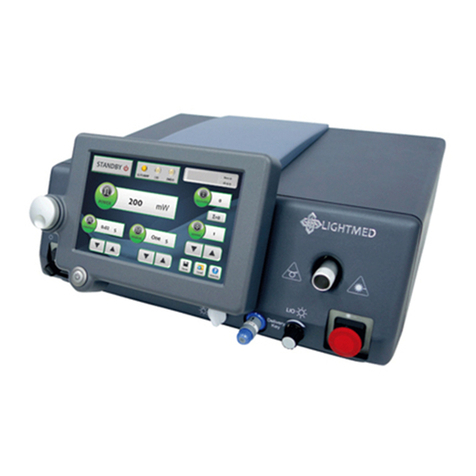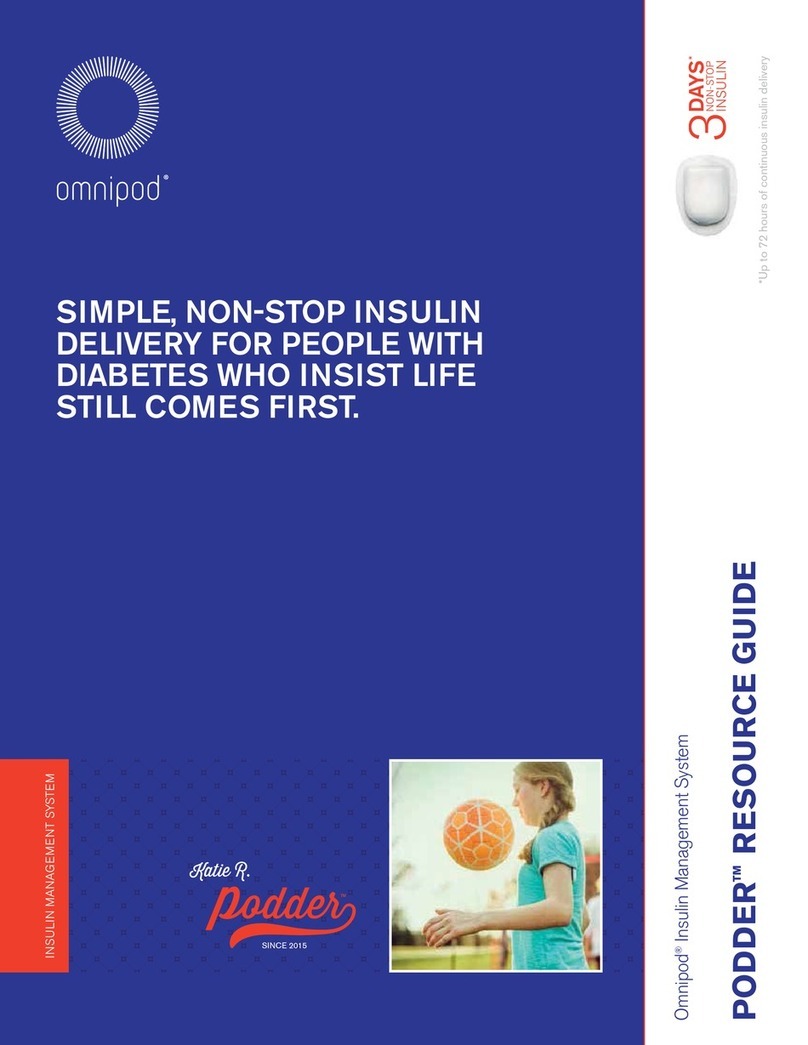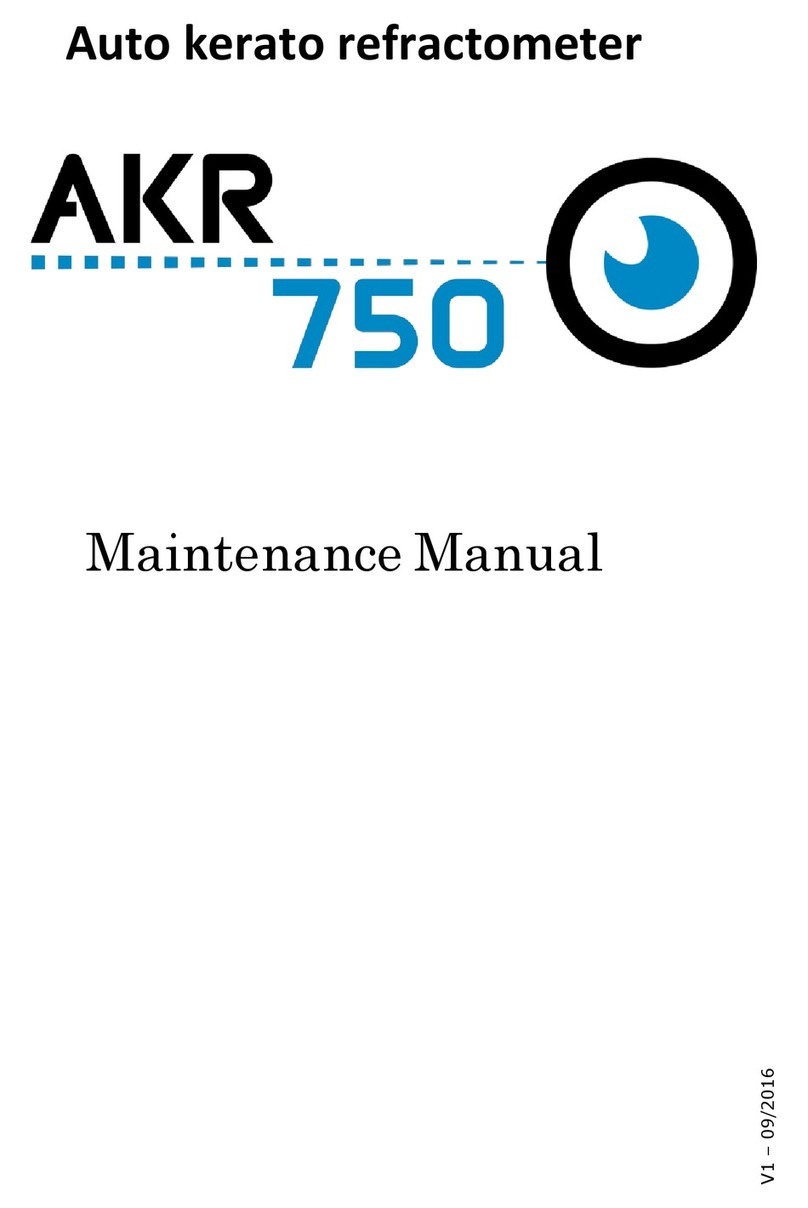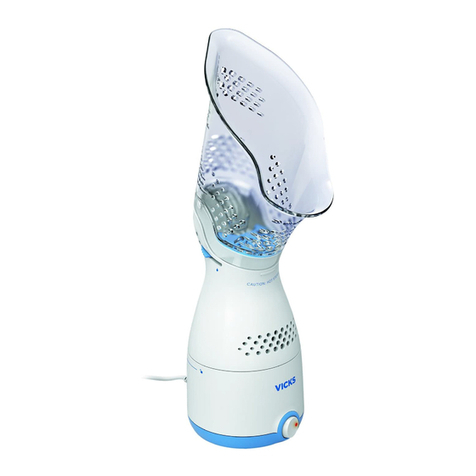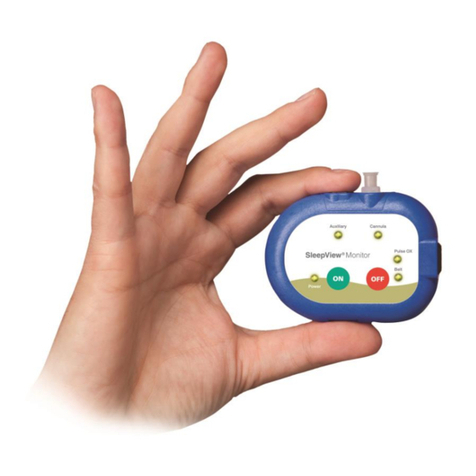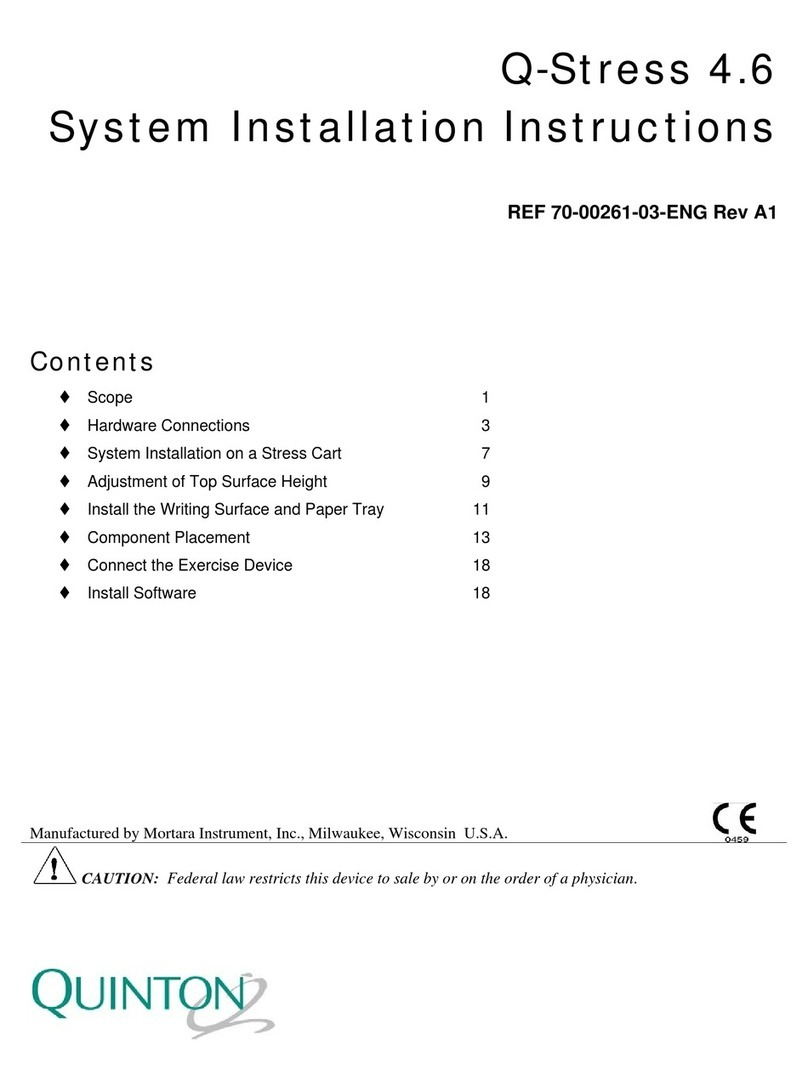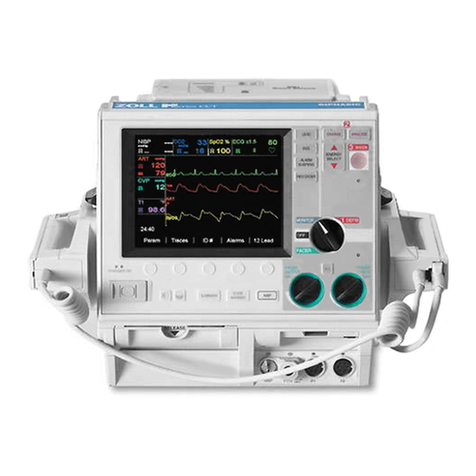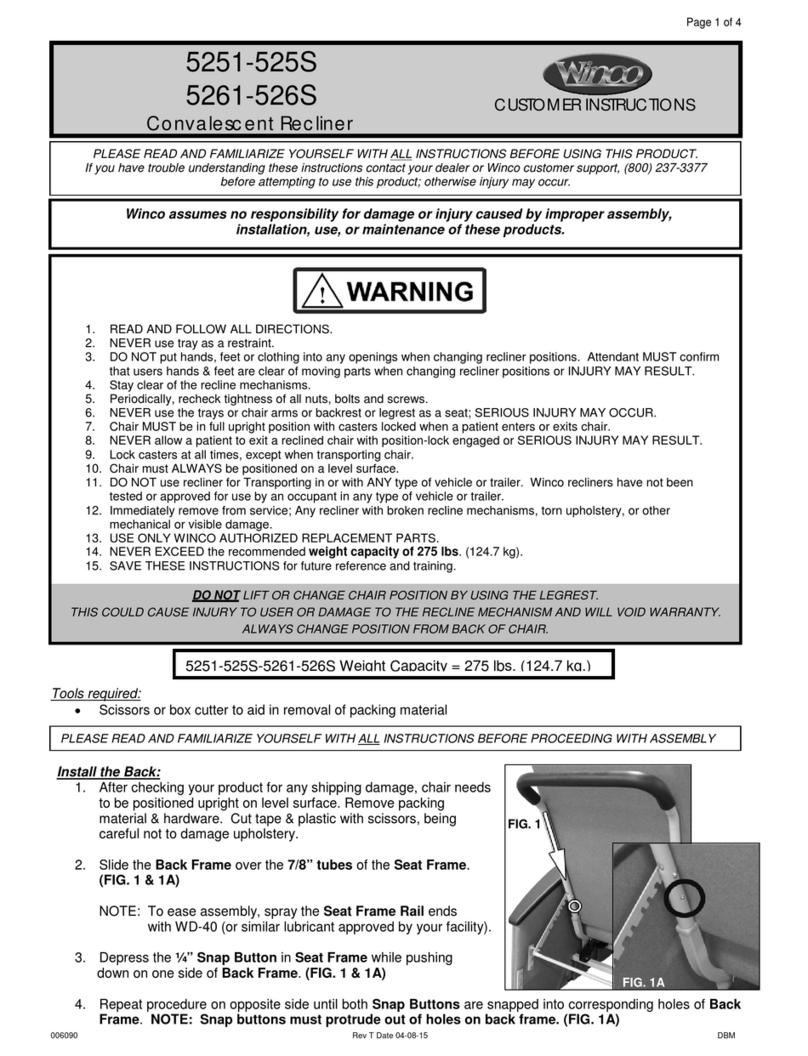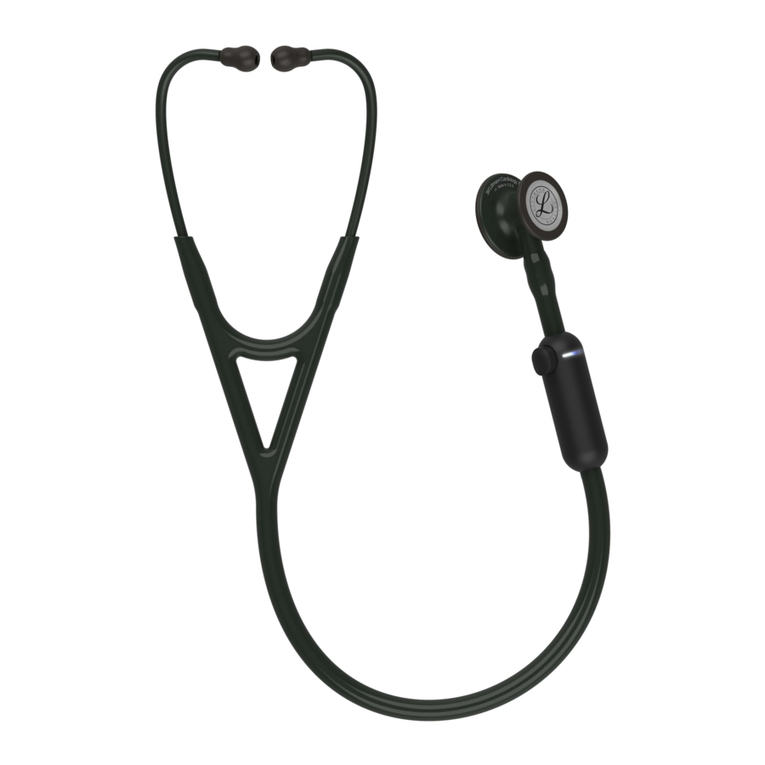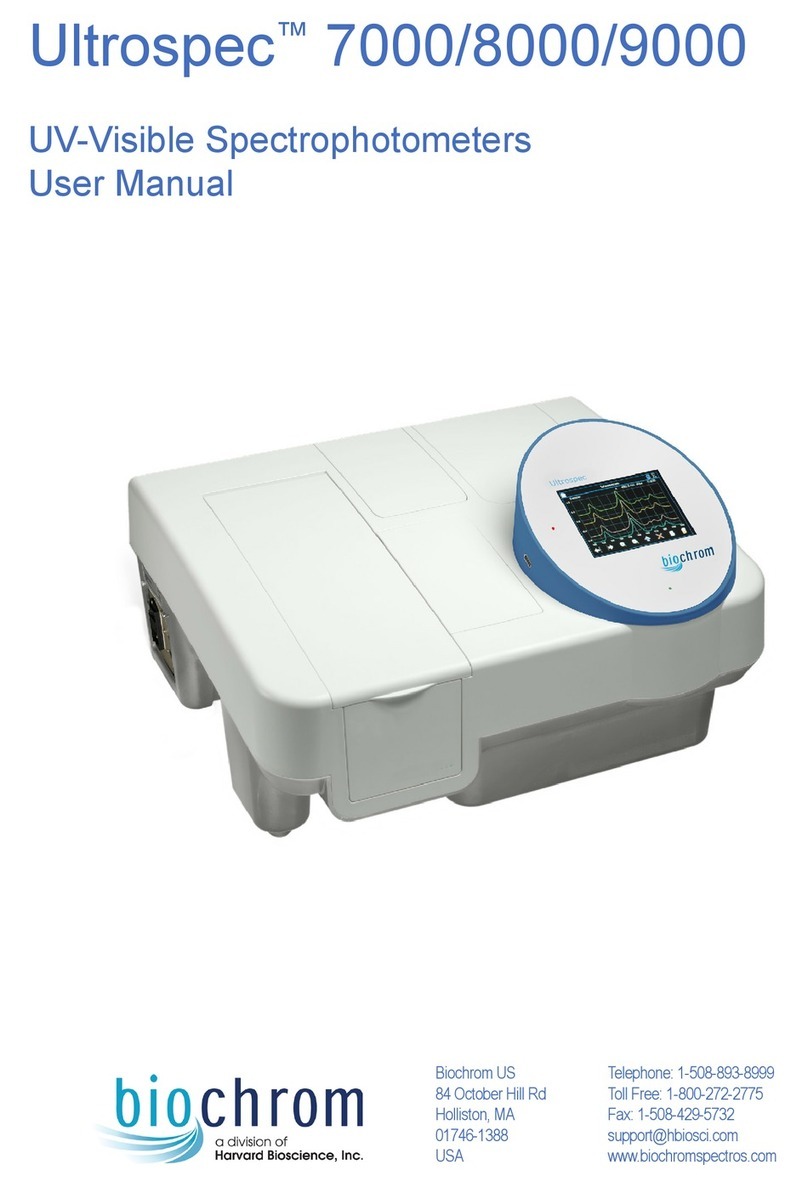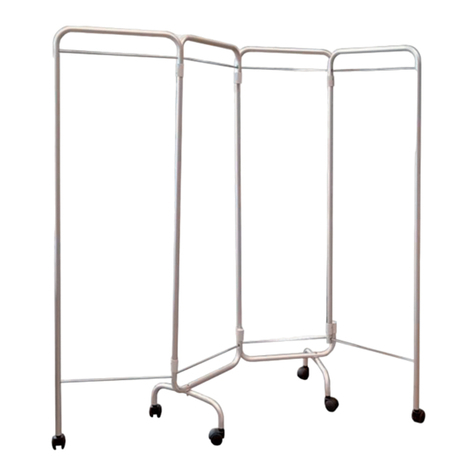Globus the winner User manual

Rev. 11.2014
1
GLOBUS
ELECTROSTIMULATION
User guide

Rev. 11.2014
2

Rev. 11.2014
3
THE ELECTROSTIMULATION...................................................................................................................................5
Types of muscle .............................................................................................................................................................5
The mechanism of the muscle contraction.....................................................................................................................5
Isotonic and isometric contractions................................................................................................................................6
CLASSIFICATION OF THE DIFFERENT TYPES OF MUSCLE FIBERS....................................................... 6
The distribution of the different types of fibers in the muscle........................................................................................7
Chronaxy and reobase....................................................................................................................................................8
Impulse parameters ........................................................................................................................................................9
Stimulation intensity ....................................................................................................................................................10
Stimulation type ...........................................................................................................................................................12
PROGRAMMING............................................................................................................................................ 14
Diagram of the programming of the EMS currents......................................................................................................15
Diagram of the programming of the TENS currents....................................................................................................15
Diagram of the programming of the DENERVATED currents ...................................................................................16
Diagram of the programming of the KOTZ currents....................................................................................................16
Diagram of the programming of the INTERFERENTIAL currents.............................................................................16
Diagram of the programming of the MICROCURRENT currents...............................................................................16
PRACTICAL APPLICATIONS ....................................................................................................................... 17
Use in sport field ..........................................................................................................................................................17
Use in beauty field........................................................................................................................................................17
Localized loss of weight...................................................................................................................... 17
Anti-cellulite treatment....................................................................................................................... 18
The lymphatic drainage....................................................................................................................... 19
Firming/Toning.................................................................................................................................. 19
Specific breast cleavage and arm firming treatment ....................................................................................... 19
Specific face treatment........................................................................................................................ 20
Applications in rehabilitation........................................................................................................................... 20
The TENS ......................................................................................................................................... 20
The MENS Microcurrents............................................................................................................................... 21
IONOPHORESIS............................................................................................................................... 23
Currents for denervated or partially denervated muscles................................................................................23
Interferential currents.......................................................................................................................... 25
Russian currents (kotz) ....................................................................................................................... 25
PROGRAM LIST“SPORT”.........................................................................................................................................27
PROGRAM LIST ”MICROCURRENTS” ..................................................................................................................38
PROGRAM LIST REHAB ..........................................................................................................................................41
PROGRAM LIST PREVENTION (available on Genesy SII-Elite SII) ......................................................................45
PROGRAM LIST SPECIAL SPORTS........................................................................................................................46

Rev. 11.2014
4
G-PULSE TREATMENTS (only in Activa, Fit&Beauty and Swing).........................................................................51
Operating mode:...........................................................................................................................................................52
The recommended accessories to carry out the 3S sequential drainage programs.......................................................53
Conductive bands................................................................................................................................... 53
“Fast band”............................................................................................................................................ 54
“Fast pad”.............................................................................................................................................. 54
Splitted cables........................................................................................................................................ 54
Electrode placement for the sequential drainage..........................................................................................................54
THE ACTION NOW PROGRAMS..................................................................................................................... 56
PERSONAL TRAINER...................................................................................................................................... 58
Use suggestions for the main programs........................................................................................................................58
ELECTRODE PLACEMENT ............................................................................................................................. 71
The body position during the stimulation.....................................................................................................................71
Electrode placement for Tens and Microcurrent programs..........................................................................................71
Bibliography...................................................................................................................................................... 84

Rev. 11.2014
5
THE ELECTROSTIMULATION
The electrostimulation does not want to replace physical activity but it must be considered as an
additional treatment to it.
According to the aims, it will be useful:
- To sportspeople, in order to complete the normal training and to increase performances
- To those who want to treat some imperfections
- To those who suffer from some pathologies
- To those who have suffered from a trauma or in the rehabilitation.
The electrostimulation is a technique that provokes a muscle contraction completely similar to the
voluntary one, by using electrical impulses that act on motor points (motoneurons) or on nerve
endings (TENS impulses).
There are two different ways of use:
- muscle stimulation (ideal for strength development and for aesthetic treatments)
- stimulation to nerve endings (ideal for the treatments against pain)
Types of muscle
The muscle can be divided in three different types: streaked or voluntary muscle; cardiac muscle
and smooth or involuntary muscle.
The voluntary muscle (streaked) includes the skeletal muscles and the musculature of organs such
as the eyeball and the tongue. It permits the movement and the maintenance of the posture and
contributes to shape the body. It responds very quickly to nerve impulses, by contracting in a rapid
and intense way. The voluntary muscle cannot be contracted for long time with high intensity
because it is subject to fatigue. Generally, streaked muscles are connected to the skeleton by means
of tendons.
The involuntary muscle (smooth) covers the internal walls of our organs, it is in the wall of the
blood vessels, in the wall of the hollow organs (stomach, intestine), inside the eyeball, in the erector
muscles of the hairs. Its main function is to push materials inside and outside the body. Smooth
muscles have very slow, but prolonged and more effective contractions (requiring less ATP). They
are not easy to fatigue and are often intrinsic and, therefore, they do not adhere to skeletal
structures.
The cardiac muscle is responsible for the continuous and rhythmic contractility of the heart and it
has some functional and structural features of the other two types of muscle tissues.
The cardiac and the smooth muscle are not voluntarily controlled.
The most part of the human body muscles belongs to the category of streaked or voluntary muscles,
with approximately 200 muscles for each side of the body (approximately 400 totally). Skeletal
muscles are the target of the EMS (Electrical muscle stimulation).
The mechanism of the muscle contraction
The skeletal muscle exercises its functions through the mechanism of the contraction.
When the muscle contraction happens, the movement of the articulations is produced and,
consequently, the movement of the skeleton, too.

Rev. 11.2014
6
The muscle contracts in the following way: when a person decides to make a movement, his/her
brain automatically elaborates the information needed and it creates a signal that, through the
nervous system, transmits an electric impulse to the muscle that has to move.
After the reception of the impulse, the anatomic structures of the muscle contract causing the
desired movement.
The energy demanded for the contraction is provided by the supply of sugars and fats stored in the
human body. In other words, the electrical stimulation is not a direct energy resource but it works as
an instrument that triggers the muscle contraction.
The same type of mechanism is activated when the muscle contraction is produced by the
electrostimulator. EMS (the electrostimulation produced by the electrostimulator) assume, in other
words, the same role of a natural impulse transmitted by the motor nervous system. Normally the
muscle relaxes and returns to its original state at the end of the contraction.
Isotonic and isometric contractions
The isotonic contraction occurs when the interested muscles produce a state of constant tension
producing the displacement of the joint heads and therefore the movement. Instead, when the
musculature produces a tension and the joint heads of a physical segment are blocked (without
moving), we talk about an isometric contraction.
In the event of the electrostimulation, an isometric contraction is preferred because it fosters to
obtain an even maximum contraction without creating sudden and uncontrolled movements of the
joint heads. Despite this, for specific applications, especially in sport field, the electrostimulation
can be used together with an isotonic contraction (with overloads, too).
CLASSIFICATION OF THE DIFFERENT TYPES OF MUSCLE FIBERS
The skeletal muscles are composed by a combination of muscle fibers that have different shapes
according to the mechanical functions they have to carry out.
I type FIBERS
This type of fibers are also called ST fibers (slow contraction fibers) or SO fibers (oxidative
metabolism slow fibers).
The motoneuron that innervates them is tonic and with slow conduction speed.
They are red fibers (the color is due to the presence of the myoglobin molecule) that have a slow
contraction speed and a mainly oxidative energetic metabolism (oxygen consumption).
I type muscle fiber is very resistant to fatigue as it is responsible for every kind of activity with a
tonic, slow nature, that is connected to the maintenance of the posture.
These fibers are surrounded by a thick capillary net that enables the optimal execution of the
aerobic metabolism in a prolonged activity that has moderate strength expressions.
I type fibers are very important in all endurance sports: running, cycling, swimming, cross-country
skiing, etc.
IIa type FIBERS
They are also called FTa fibers (rapid contraction fibers) o FOG fibers (oxidative-glycolytic
metabolism rapid fibers).

Rev. 11.2014
7
These fibers are to be considered intermediate between the I type fibers and the IIb type fibers; they
are innervated by a phasic motoneuron that has a faster speed than the one of the tonic motoneuron.
Thanks to their features, they can specialize by addressing them towards more aerobic or anaerobic
metabolic properties.
Therefore, the IIa type fiber is able to carry out rapid contractions with a modest strength
development, that are extended during the time due to their relative endurance to fatigue.
IIb type fibers
They are also called FTb fibers (rapid contraction fibers) or FG (glycolytic metabolism rapid
fibers).
This kind of fiber is innervated by a phasic motoneuron that transmits the impulses to the muscle at
a very high speed.
These fibers are white and have a high content in glycogen and glycolytic enzymes to develop a
powerful energetic anaerobic activity.
The contraction is very rapid and develops high strength values; the almost complete lack of
mitochondria makes these fibers not able to support an extended activity and, thus, easy to fatigue.
IIb type fibers are very important in all human activities that have explosive strength expressions
and, naturally, in all power sports: sprints, throws, jumps, etc.
The limits of the actual classifications
The actual classification of muscle fibers is due more to the need of establishing a series of
categories to use for practical aims than to the biological-functional reality of the human muscular
system.
It is certain that the fibers are in a continuous range of different metabolic organization levels that
correspond to the different types of human activity, generally, and sport performance, specifically.
The distribution of the different types of fibers in the muscle
The relation between the two main categories (type I and the type II) can vary in a sensitive way.
There are muscular groups that are typically constituted by fibers of I type, like the soleus, and there
are muscles that have only fibers of II type like the orbicular muscle. However, in the most of the
cases we have a simultaneous presence of various types of fibers.
The studies lead on the distribution of fibers in the muscle have put in evidence the strait
relationship that exists between the motoneuron (tonic or phasic) and the functional features of
fibers from it innervate. They have also shown as a specific motor activity (and sports in particular)
can determine a functional adaptation of the fibers and a modification of their metabolic features. In
the same way, also the training with the electrostimulation enables the training to focus on some
types of fibers rather than on other types, by modifying the parameters of frequency and duration of
the impulse, according to the results achieved.
Motor unit type
Contraction type
Contraction frequencies
I type fibers
Slow contraction I
0 - 50 Hz
II a type fibers
Fast contraction II
50 - 70 Hz
II b type fibers
Fast contraction II b
80 - 120 Hz

Rev. 11.2014
8
In order to make a tissue pass from the phase of rest to the one of excitation by means of an induced
electrical stimulus (impulse of the electrostimulator), some factors have to be considered:
- the stimulation intensity
- the duration of the stimulation that must be adapted to the body district that is wanted to be
stimulated.
Indeed, to excite a tissue, not only the pick intensity value is particularly important, but also the
relationship between the duration and the intensity of the stimulus.
This relationship varies according to the muscular districts.
Chronaxy and reobase
The graphical course that represents the relationship between the intensity of a stimulus (l) and its
duration (t) is not linear, as the studies carried out by Lapique demonstrate. Observing img. 1,
which shows the relationship between intensity and duration of an electrical stimulus provoked to
excite a target tissue, it turns out to be obvious that, an increase in the duration of the stimulus
corresponds to a decrease in its intensity.
Image 1
However, it does not spoil its effectiveness. On the other hand, when a stimulus of short duration is
wanted to be used, its intensity will have to increase for being able to reach the excitation threshold.
Lapique's important discover consists in having understood that for being able to obtain an
electrical stimulus, qualitatively valid, it is not sufficient to establish a parameter and consequently
derive the other. That depends on the intrinsic features of the organic tissues, which try to get
accustomed to a constantly repeated stimulus. This phenomenon, called "tissue accommodation",
involves the realization of a stimulus that does not depend on it.
The two parameters individuated by Lapique, necessary in order to obviate the problem, are:
REOBASE and CHRONAXY.
REOBASE: it is the value of minimum intensity in order to excite the tissue independently from its
duration.
CHRONAXY: it is the duration of the stimulus, with a double intensity compared to the reobase, it
is necessary in order to excite correctly the target tissue.
Once the chronaxy has been identified, a suitable stimulus is automatically produced to excite
correctly the target muscle group. In this way it is also possible to avoid all those typical
annoyances of an extended electrical stimulation such as a burning sensation and formication.
During the researches to define the electrostimulation programs, therefore, it is indispensable to
consider the chronaxy, which varies according to the muscular group that you want to stimulate.

Rev. 11.2014
9
Body Part
Chronaxy
Leg
400 μs
Thigh
350 μs
Lower trunk
300 μs
Upper trunk
250 μs
Arm
150 μs
Forearm
200 μs
Table of the values of chronaxy of the different body parts
Impulse parameters
Recent researches have explained that the muscle contracts in various ways according to the type of
stimulation it has received and according to the parameters that characterize it: intensity, frequency,
amplitude of the impulse, duration and recovery time.
The parameters that characterizes an electrical impulse are:
-frequency
-amplitude
-intensity
The frequency suggests how many impulse cycles occur in a second. It is expressed in Hertz. This
value affects the fibers that will be stimulated: the higher the frequency is, the more the stimulation
aims to fast fibers. At low frequencies, slow fibers are stimulated.
Image 2. In the first graphic the frequency is 10 Hz, in the second one it is 4 Hz.
EXAMPLE:
frequency fiber type (work)
10/50 Hz Slow fibers –Endurance
50/70 Hz Intermediate fibers
70/100 Hz Fast fibers - Strength
100/120 Hz Fast fibers
I
Impulse cycles in 1”
Impulse cycles in 1”

Rev. 11.2014
10
The amplitude is the duration value of the impulse. It is measured in microseconds and represents
the chronaxy value of the motor nerve that innervates the muscle to be treated.
EXAMPLE:
150-250 ms Upper limbs
350-450 ms Lower limbs
250-350 ms Trunk
The intensity is the value of the electrical current that can be set by the user and it is measured in
mA (microampere). Higher the intensity, greater the number of the fibers recruited.
Stimulation intensity
The intensity of current necessary to obtain muscular contraction is personal and depends on the
position of the electrodes, the underlying adipose tissue, sweating, the presence of hair on the area
to be treated, etc.. For these reasons, the same intensity of current can generate different feelings
from person to person, from day to day, and from the right side to the left side of the body. During
the same working session, it will be necessary to regulate the intensity in order to obtain the same
level of contraction because of the accommodation phenomena. The intensities of current
recommended in the different phases are proposed as indicative values, and each person should
modify these levels according to his/her personal needs.
- Moderate intensity. The muscle does not tire, not even during prolonged treatments. The
contraction induced is tolerable and pleasant. This is the first level on the graphic representation of
intensity.
- Intermediate intensity. The muscle is visibly contracted but the stimulation does not cause the
joints to move. This is the second level on the graphic representation of intensity.
- Elevated intensity. The muscle is contracted substantially. The muscular contraction will cause the
extension or bending of the limb if this is not blocked. This is the third level on the graphic
representation of intensity.
- Maximum intensity. The muscle is contracted maximally. This is an intense treatment that should
be performed only after having executed different applications at lower intensity.
I
T
I
T

Rev. 11.2014
11
In the descriptions of the treatments, the best levels of intensities are recommended.
NOTE: The recommended levels of current are only indicative.
NOTE: For Microcurrents programs, it is not necessary to set an intensity value (in mA) because
this is preset and automatically activated for all phases.
Moderate
Maximum
Elevated
Intermediate
From 10 mA to 20 mA
At the maximum level of tolerance, but below the pain
threshold
From 30 mA to 40 mA
Above 30 mA

Rev. 11.2014
12
Stimulation type
Globus electrostimulators offer different stimulation modes: continuous, intermittent, frequency
modulation, amplitude modulation and BIO-PULSE®.
Continuous stimulation
It consists in a continuous stimulation without times of recovery all the phase long.
This type of stimulation is generally used, in order to execute treatments of warm up and cool-down
at low frequency (with TENS currents) or for antalgic treatments.
Intermittent stimulation
During this type of stimulation there is an alternation between working time and rest time (active
and passive); there can be, for example, 6 seconds of contraction and 10 of recovery, after that the
contraction starts up again for 6 seconds and so on for all the duration of the phase.
During the time of recovery, there is also the possibility to raise the intensity of current in order to
execute a cool-down active recovery during the rest.
Frequency modulation stimulation
In this type of stimulation, during the working phase, the frequency of the stimulus varies between
the predefined values in order to involve the greater number of muscular fibers. They are used for
aesthetic treatments and also for specific programs, such as programs of explosive strength.
Amplitude modulation stimulation
Ramp-Down
Rest
Ramp-Up
Stimulation
I
T
I
T

Rev. 11.2014
13
In this type of stimulation the frequency remains constant while the amplitude of the impulse varies
progressively between the predefined values. It is indicated mainly for aesthetic and fitness
treatments.
BIO PULSE stimulation
It must be considered a true and proper Globus innovation (studied in collaboration with some
Italian and foreign Universities). It consists in a particular type of modulation of the amplitude of
the impulse and of the stimulation frequency, too.
The Bio Pulse stimulation is particularly indicated for beauty and wellness programs such as some
kinds of lipolysis and drainage and, above all, programs of relaxing, deep and anti-stress massage.
I
T

Rev. 11.2014
14
PROGRAMMING
In the most of Globus electrostimulators there is a function that enables the user to set the programs
in a very specific way and according to the current needs. The personalized work can create a very
specific training and a rapid achievement of the proposed results inn sport field and rehabilitation,
fitness and in beauty field.
It is clear that the use of this special function of the principal Globus electrostimulators needs a
deep knowledge of the electrostimulation field and especially an optimal experience in the field,
firstly made with the preset programs to be personalized further.
The currents that can be programmed vary from device to device and are:
- EMS;
- TENS;
- Interferential;
- Microcurrents;
- Denervated;
- Kotz.
Here we just want to offer some general notions on the parameters that can be set to create a new
program.
To program the electrostimulator correctly it is important to consider three different factors that
characterize the impulse: the ramp up, the stimulation time and the ramp down.
With the term “Ramp-up” we mean the time that the stimulation intensity needs to pass from the
value of 0 to the preset value during the working phase. Therefore, it represents the time that the
muscle needs to reach the maximum contraction set. The ramp up varies according to the features of
the program chosen. The choice of the ramp up is in a strait relationship with the physical and
muscular features of the athlete, of the sport practiced and of the goal you want to reach. It is
important to consider that too brief ramps reduce considerably the comfort of the stimulation and
they are difficult to manage by the person that is carrying out the treatment, as he has not enough
time to prepare to the contraction. In the same way, too long ramp time can fatigue the muscle even
before the contraction ends.
With the term “Ramp-down” we mean the time needed for the intensity to return to 0 after the end
of the contraction. Even in this case it should be considered that too rapid ramp down times can be
less comfortable because the subject does not have the time needed to support the voltage drop,
while too long ramp down times can anticipate the feeling of localized fatigue.
With the term “stimulation time”we mean the time the musculature keeps the maximum
contraction reached. The duration of the working phase does not have a fix value but is has to be
established according to the muscle qualities you want to train.

Rev. 11.2014
15
Diagram of the programming of the EMS currents
Diagram of the programming of the TENS currents
* With the term “Tens burst” in the
stimulation during the rest, we mean a
burst constant, that is a constant
current in the form of brief impulse
packages.

Rev. 11.2014
16
Diagram of the programming of the DENERVATED currents
Diagram of the programming of the KOTZ currents
Diagram of the programming of the INTERFERENTIAL currents
Diagram of the programming of the MICROCURRENT currents

Rev. 11.2014
17
PRACTICAL APPLICATIONS
Use in sport field
Different kinds of strength exist and they are measured in different ways. The maximum
development of strength is the absolute strength, without considering the body
weight; instead when the body weight is considered, we are talking about the
relative strength.
Here’s an example. We know that an ant is able to move an object that weights six
times more than it does, therefore it has a relative strength greater than any other
weight lifter, even if its absolute strength can be considered paltry.
Another element to be considered is the kind of effort made. For example, the running of a one
hundred meters runner is a performance very different from the one of a marathon runner and it
develops different strengths.
When the stimulation that our muscle bear is brief, intense and immediate, then we are measuring
the rapid strength. When it is extended during the time (and it requires the organism countering
certain fatigue), we are measuring the endurance strength.
Obviously, every kind of strength will have a training and a specific load to increase it.
Use in beauty field
The electrostimulation treatments in beauty field can be distinguished in two big
areas:
-specific programs to treat skin flaws: improvement of the capillary
microcirculation, toning and tissue firming, liquid drainage, increase in metabolism
and cellular activities, reduction and mobilization of the fat in the localized
deposits (e.g. cellulite, water retention, localized fat, …);
-toning or firming programs: for those who want to firm and tone their muscles but do not have
enough time to practice motor activity.
For long-lasting results, it should be used together with motor activities, as soon as possible. As you
will see, these programs contribute to reduce skin flaws through the general and localized increase
in the metabolism.
Among the innumerable applications in beauty field, we briefly summarize some of the main aims.
- Loss of weight/ Localized lipolysis
- Anti-cellulite treatment
- Lymphatic drainage
- Firming/Toning
Localized loss of weight
It is known that, when a person goes on diet, he/she loses fat more quickly in the areas where he/she
is already slim. For instance, when going on a diet, a woman, who does not have a voluminous
breast and wants to lose weight because of her large hips, is going to lose weight in the breast and
not in the hips.
To obviate the problem, it is necessary to resort to the so-called “localized loss of weight”, that is
the losing weight process that, through the increase in the muscle activity, enhances the
mobilization of the fat from the adipose tissue (lipolysis) in the areas next to the activated muscles.
Love handles

Rev. 11.2014
18
If the cellulite on hips is a feminine problem, love handles are instead almost exclusively a man
problem. Both are difficult to tackle; gym, diet, aerobic work, and more, often permit to obtain only
mediocre results.
Electrostimulation can contribute in an effective way to treat this skin flaw because, being a
localized treatment, it acts directly on the problem.
In this case it is necessary to have the maximum perseverance and especially the possibility to act
more times per day, or at least every day, with specific electrostimulation programs localized on the
areas to be treated.
Anti-cellulite treatment
The cellulite is a sworn enemy of woman body. Its elimination is not only an aesthetic caprice, as it
is a real “ILLNESS” to tackle and treat from its first symptoms.
The causes that can lead to the appearance of cellulite are different (they often act together to make
it difficult to treat): bad alimentation behaviors, lack of exercise, changes in body weight, bad
circulation, ineffective lymphatic drainage, deposit of excess fat, water retention, family genetic
predisposition, teen-age overweight, little elastic skin or not healthy skin, stress.
The cellulite, which usually appears on feminine body rather than on masculine body, can be of
different types:
EDEMATOUS cellulite: it is the first the stage of the cellulite and it is possible to recognize it
because the skin, in the critical points, is doughy and when pinching, it presents bumps and it
presents the orange peel skin effect. The edematous cellulite is caused by a loss of elasticity of the
blood vessels that supply blood to the adipose tissue by causing the liquid stagnation. The cells, that
are inflamed, strain blood circulation, by causing firstly swallowing and secondly anti-aesthetic
tires.
FIBROUS cellulite: it is the second stage of cellulite. The continuous liquid stagnation makes the
adipose tissue suffer and it becomes fibrotic. The skin begins to harden and to become dull. The
orange peel effect is evident even without pinching the skin.
SCLEROTIC cellulite: it is the final result of the process of tissue degeneration. At this stage, the
hardened nodules are very evident so that the skin looks like a “mattress”. In this third stage, the
cellulite cause a considerable suffering to the tissues and the adipose cells increase in number and
volume and the fibrous septa that separate them tend to stiffen and to shrink. This makes the nerve
endings compress and even just touching the critical points causes pain.
To tackle cellulite it is important the use of electrostimulation; indeed, like in an aerobic training, it
produces an improvement in the lymphatic drainage and in blood microcirculation, that
physiologically are the mechanisms intended to eliminate the excess fat. With the electrostimulation
the treatment can be aimed at delimited areas and therefore it has a greater possibility of success.
The treatment must be always used together with other means that we have at our disposal today.
Firstly, it is necessary to try to improve the skin health, at least because with healthy skin, cellulite
is less evident. Then it is better to eliminate or at least to limit smoke, alcohol and fat assumptions
(especially saturated fats of animal origin). Moreover, it will be useful to drink a lot of water poor
of sodium, to eat a lot of vegetables and fresh fruits (especially fruits with more water and
antioxidants, or with A, C, E vitamins and zinc and selenium).and to massage the areas in order to
improve the circulation and the lymphatic drainage and to limit stress.
To sum up: the anti-cellulite strategy must base on five main factors that are diet, exercises,
massages, natural integration and electrostimulation.

Rev. 11.2014
19
The lymphatic drainage
Together with the blood, the lymph represents the means by which the interstitial liquid give and
receive nutrients, refusal and regulation substances (hormones) that are needed to maintain the
integrity and the cell functionality. Compared with blood, lymph is not pushed by the cardiac
activity, but it flows in the vessels because of the muscle action. These tissues, by contracting and
relaxing, act like a real pump. When this action does not occur, for example due to immobilization,
the lymph tends to stagnate, amassing in the tissues. This is the reason why feet and ankles swallow
when standing for a long time in a static position.
The “drainage” concept refers to the starting of the liquid from the area where it has been amassed
towards an outfall point.
The lymph drainage supports not only this flow, by moving the liquids in the body, but it also acts
to unblock the obstructed channels.
It is an effective technique also to prevent and reduce the unaesthetic orange-peel aspect of cellulite.
It is indicated in the treatment of pathologies (post-surgical edema, scars), but in this case we
suggest that the medical prescription must be specific and personalized.
The programs of drainage and lymphatic massage, carried out with the electrostimulator, can be
used daily and are indicated especially for those who suffer from limb swelling or show, at the end
of the day, a sense of muscle fatigue.
Thanks to the rhythmic contractions induced by the electrostimulator (programs that link the
stimulation in frequency modulation to the amplitude modulation), the so-called “pump effect” is
obtained and it permits a reabsorption both of the water component and of the protein component
inside the lymphatic ducts.
Firming/Toning
Some factors, such as sudden loss of weight, pre- and post-cellulite status or pregnancy, often affect
in a negative way elasticity and the tone of skin and muscle tissue, making some body parts flabby
and less tonic.
The “Firming” programs of our electrostimulators are specific and indicated for this kind of
problem, as they permit to act locally on the muscle tone involved.
Muscle tone activities are instead intended to increase the percentage of lean mass and therefore to
give more consistence and shape to the muscle tone.
Specific breast cleavage and arm firming treatment
Breast, cleavage and arms are the first areas in the feminine body that show symptoms of muscle
relaxation. As for the breast, among the factors that determine its relaxation, reduction and the
appearance of stretch marks, it is to mention especially pregnancy and lactation and too drastic and
rapid loss of weight and hormone disorders. The only support musculature of the breast consists in
the pectoral muscles situated in the area above.
The mammary area, therefore, is one of the parts of the feminine body more exposed to the problem
of muscle-skin relaxation. The cleavage is instead one of the areas more exposed to the damages of
sun exposure; the consequent skin degeneration prematurely arises with the appearance of spots,
keratosis and dehydration. As for the internal part of the arms, we can notice how the skin flaws
most spread are cellulite, loss of volume, skin relaxation and stretch marks.
The electrostimulation can be useful in tackling these problems by using specific firming programs
for women daily.

Rev. 11.2014
20
Specific face treatment
The electrostimulation is effective to recover and maintain the skin elasticity as it reactivates the
local circulation bringing new nourishments to the tissues.
The microlifting programs, specific for face, need specific electrodes of reduced dimensions in
order to involve only the interested musculature
Applications in rehabilitation
After a force immobilization due to a musculoskeletal trauma, it is very important to recover the
tone and the muscle trophism. Electrostimulation permits to recover the muscle tone quickly and to
drain the liquids stored because of the immobility.
Please, bear in mind that the electrostimulation should not completely replace the reeducation
sessions made by a physiotherapist, who could decide to carry out also proprioceptive and mobility
exercises.
The presence of ostheosynthesis devices, such as screws and plates, is not a contraindication in the
use of the electrostimulator as it has been conceived not to damage that devices.
Before starting any rehabilitation cycle, we suggest seeking your physician’s
advice.
The TENS
The transcutaneous electrostimulation (TENS) is widely used to reduce most of
the articular or muscle pains but also to treat pain of endogenous origin as they have little side
effects compared with traditional pharmacotherapy and therefore they are considered an important
alternative therapy.
The TENS consist in the selective stimulation of big fibers of peripheral nerves favoring the closing
of the gate for pain receptors and increasing the release of endorphin substances with a consequent
considerable reduction of the intensity of different kinds of pain. With the TENS programs of our
electrostimulators, therefore, we intend to treat acute and chronic pain due to the main
musculoskeletal disorders.
The pain decrease following the TENS currents application is connected to these factors:
a. Gate control theory
b. Endorphin secretion
c. Different sedative effects in relation to the frequency
Gate theory
If the electric signals that lead to the brain information about pain are stopped, also the pain
perception is eliminated. If, for instance, we hit our head into an object the first thing we do is
massaging the area affected by the trauma. In this way, we stimulate the receptors relative to touch
and pressure. TENS in continuous mode and in frequency modulation can be used to generate
signals similar to the ones of touch and pressure. If their intensity is enough, their priority is so high
that it prevails on the pain signals. Once the priority is gained, the gate related to the sensory signals
is opened and the pain one is closed, impeding in this way the passage of these signals to the brain.
Endorphin secretion
When a nervous signal proceeds from the pain area to the brain, it spreads through a chain of
connections joined together called synapse. The synapse can be seen as the space between the end
Table of contents
Other Globus Medical Equipment manuals
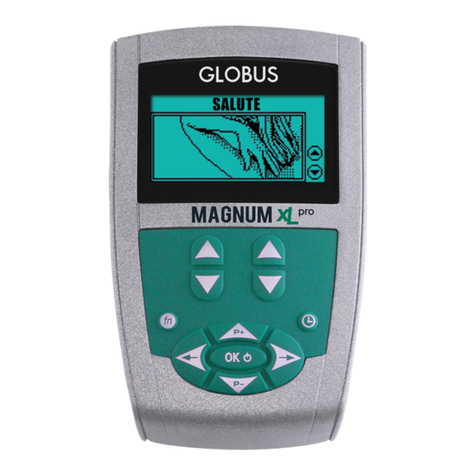
Globus
Globus Magnum XL User manual

Globus
Globus Magnum XL PRO User manual
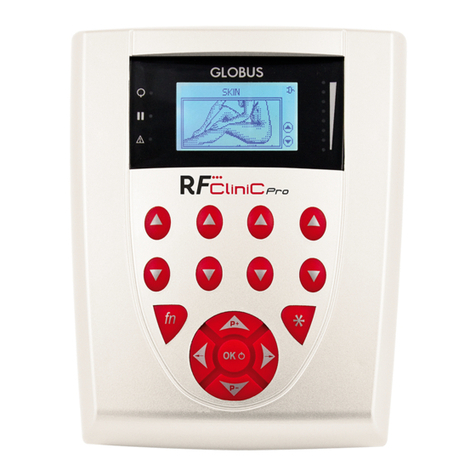
Globus
Globus RF CLINIC PRO User manual
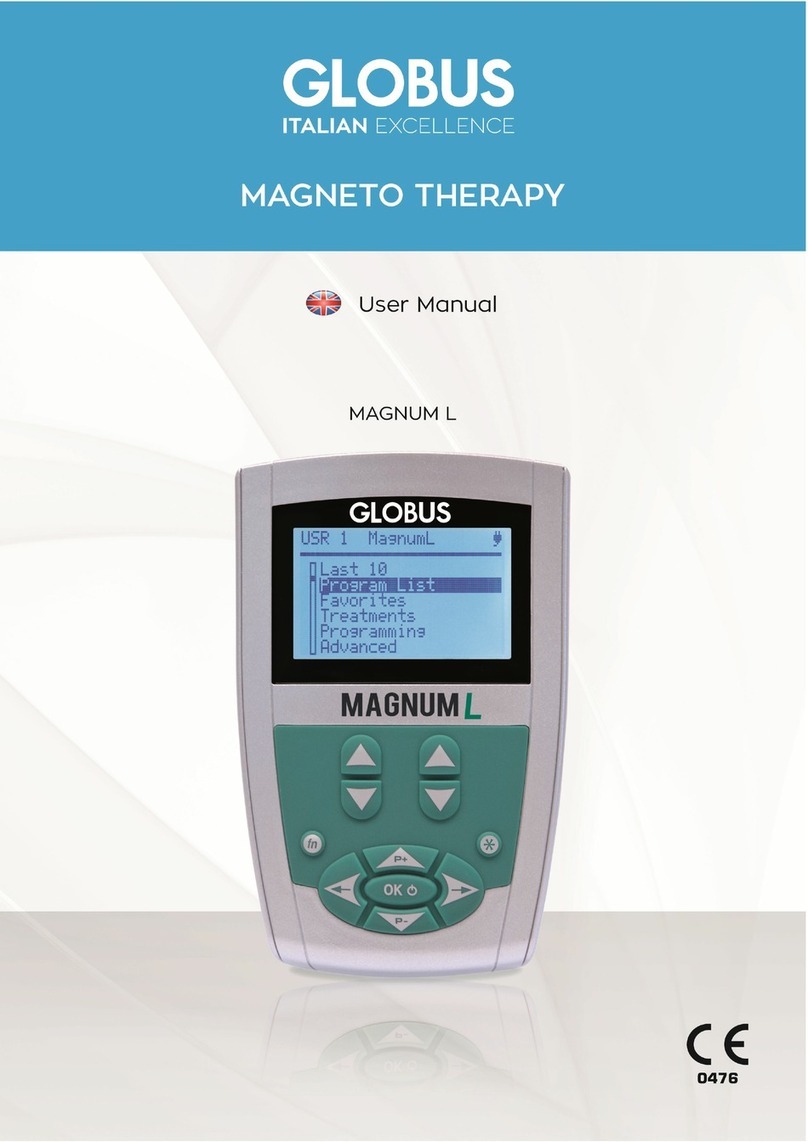
Globus
Globus MAGNUM L User manual

Globus
Globus RF Beauty 6000 User manual

Globus
Globus Magnum XL User manual
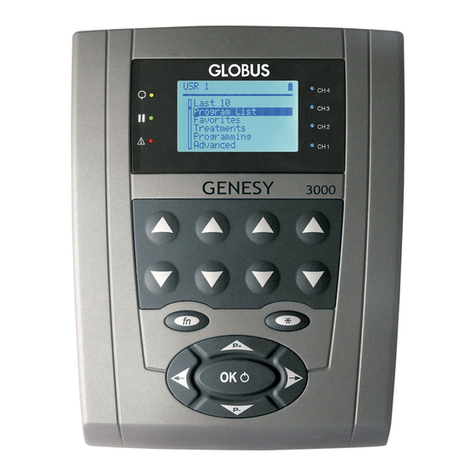
Globus
Globus Genesy 3000 User manual
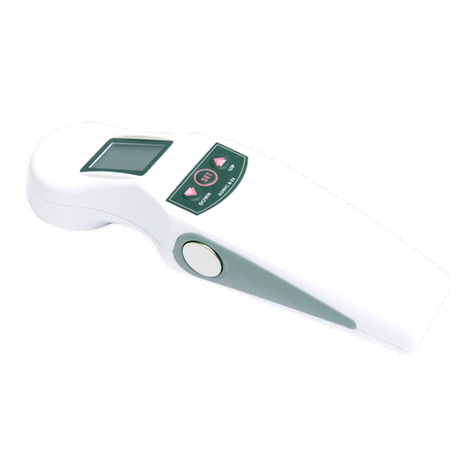
Globus
Globus Medisound 922 User manual
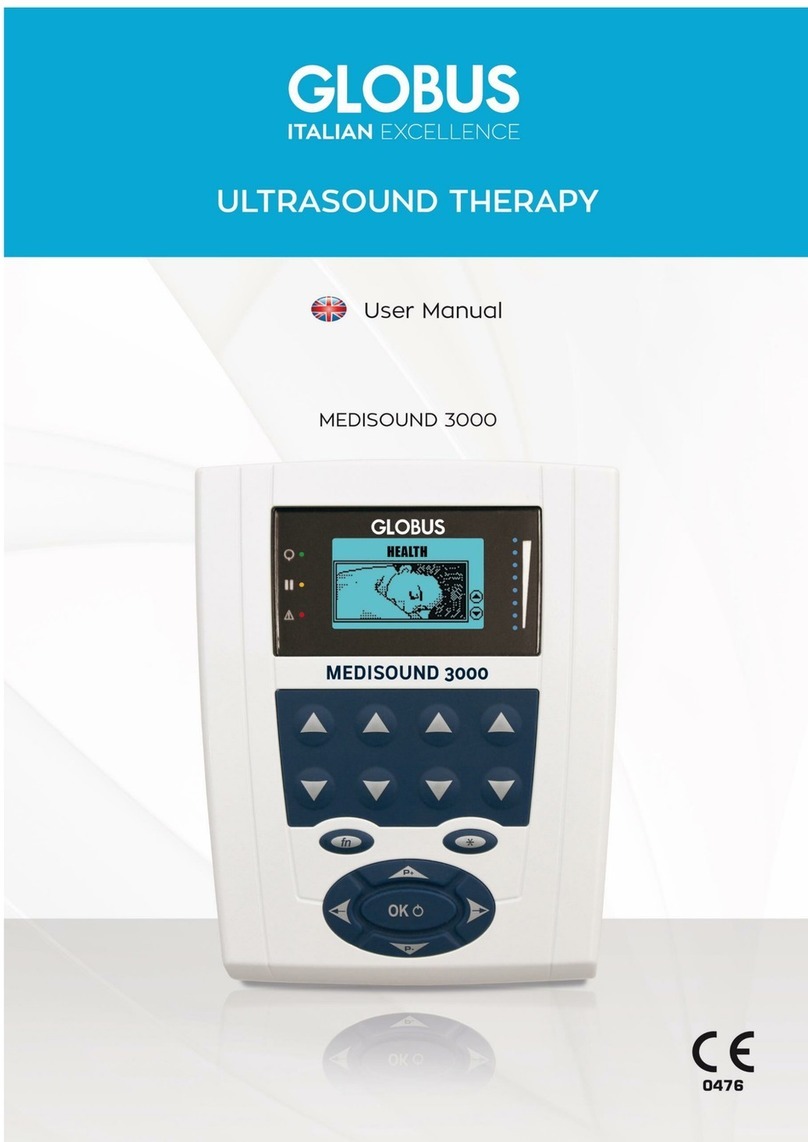
Globus
Globus MEDISOUND 3000 User manual

Globus
Globus Genesy 3000 User manual



